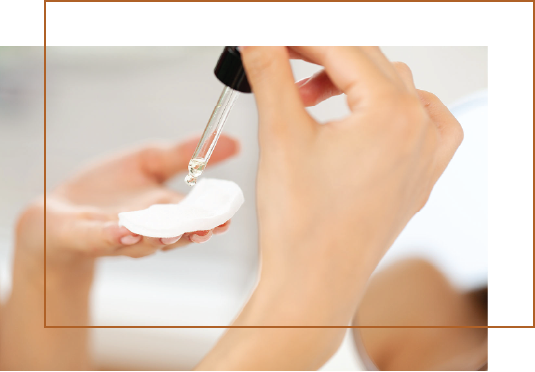Derma Vyrome
Skin Prebiotic
Derma Vyrome is designed to support a healthy skin microbiome and phageome.
Derma Vyrome is designed to support a healthy skin microbiome and phageome.
Shake well before use. Put a few drops on a cotton ball/swab and rub vigorously on affected skin twice a day, or as needed.
**Individual needs may vary; please consult your practitioner before altering the prescribed doses or protocols.**

Bacteriophages, commonly referred to as phages, are the most abundant organisms in the ecosystem. They are viruses that infect bacterial cells as part of their life cycle. Phages are classified into related groups, much like other organisms on the planet. These related groups of phages target specific types of bacteria and rarely interact outside of these target groups. Because phages interact so closely with bacteria, they play a crucial role in the microbiome as a whole. Phages are integral to maintaining a healthy, balanced skin microbiome. By controlling bacterial overgrowth, they prevent pathogens and opportunistic bacteria from causing disease and help maintain optimal levels of symbiotic bacteria.1

Dysbiosis, the disruption of the delicate balance of the skin microbiome, can be caused by multiple factors. Lack of use or access to hygiene products, overuse of antibiotics or steroids, disruption of the gut-skin axis, misuse of cosmetic products, environmental changes, and more can lead to skin microbiome dysbiosis. Dysbiosis can contribute to or worsen skin conditions such as acne vulgaris, atopic dermatitis, psoriasis, keratosis pilaris, and others. Many of these conditions can compromise the skin barrier, resulting in pain, inflammation, open wounds, severe itching and irritation, poor wound healing, scarring, hyperpigmentation, and secondary infections. Additionally, skin conditions can impact confidence and mental health. Restoring a healthy skin microbiome is a key factor in healing the skin barrier and promoting overall skin wellness.2
Derma Vyrome offers a gentle and effective method for combating skin dysbiosis.3 By utilizing the innate mechanisms of skin health and replacing missing or deficient phages, it helps restore the skin barrier and its microbiome to their natural, balanced state without the need for harsh products. The phages included in Derma Vyrome have been shown to disrupt biofilms, which are often resistant to antibiotics and other forms of bactericidal treatments.4 For those who prefer to avoid or have not found success with conventional treatments methods for various skin conditions, Derma Vyrome provides a path to naturally restored skin wellness.
The Siphoviridae phage provided by Derma Vyrome was selected for its ability to target the most common acne-causing bacteria, Cutibacterium acnes. By reducing the population load of C. acnes living on the skin, this phage helps to reduce both the frequency and severity of breakouts. Reducing breakouts is important not only for enhancing self confidence and cosmetic appearance, but also for alleviating the pain, inflammation, and risk of secondary infections associated with breakouts.
Skin lesions of all types compromise the skin barrier, making these areas vulnerable to further damage and infection. Ensuring efficient and high-quality healing of skin lesions is paramount to prevent worsening skin conditions and poor healing outcomes. Phages help by reducing the populations of opportunistic bacteria, thus preventing both primary and secondary infections in skin lesions.
Phages play a key role in maintaining the skin microbiome. By targeting and killing pathogenic bacteria, phages help repair skin microbiome dysbiosis. A healthy skin microbiome is a critical part of skin wellness as it educates the immune system, prevents pathogen overgrowth, produces beneficial metabolites, and stimulates the production of skin-boosting molecules like collagen. Using phage therapy supports a robust skin barrier and clearer skin by promoting a balanced skin microbiome and phageome.
Skin conditions can be incredibly difficult to treat, and often require multiphasic treatments even if individual products have been effective on their own. A leading cause for concern is the overuse of antibiotics, steroids, and other medications that can alter hormone production. Phages offer a natural and gentle alternative to these potentially aggravating and complicated treatments.
Derma Vyrome’s exclusively researched and developed phages specifically designed to target pathogenic and opportunistic bacteria that are known to contribute to skin conditions. Building on cutting-edge medical advancements in phage therapy, this product leverages exclusive phages to address bacterial infections. By harnessing phages’ natural biological mechanisms, Derma Vyrome unlocks a new world of skin wellness by promoting optimal skin health the way nature intended.
Derma Vyrome is a hand curated formula of phages designed to support the proper balance of the skin microbiome and phageome. It works by targeting harmful and opportunistic species of bacteria that live on the skin, and sometimes in the body, preventing them from overgrowing and resulting in various disease states. As natural components of a healthy skin microbiome, phages are essential to optimizing skin health, and Derma Vyrome helps fill this critical gap in skin care.

Myoviridae is a family of viruses known as bacteriophages, or phages, that targets specific bacterial cells. Myoviridae specifically targets the pathogenic bacteria, Staphylococcus aureus. While S. aureus typically lives on the surface of the skin without causing any issues, if the skin is damaged in any way, it can use this opportunity to invade the wound and cause serious, potentially life-threatening infections. Although antibiotics have been used to treat S. aureus infections, certain strains of S. aureus have developed resistance to these antibiotics due to improper use. These strains of S. aureus are known as Methicillin-resistant Staphylococcus aureus (MRSA). These resistant strains pose a greater danger because they cannot be treated effectively with antibiotics and other conventional treatments. While new treatment methods are in development, phages that target S. aureus and MRSA offer a promising alternative. One reason why phages are beneficial in cases like these is that they are highly specific, whereas antibiotics can indiscriminately kill both beneficial and pathogenic bacteria, further perpetuating dysbiosis. Research shows that topical application of Myoviridae serum effectively destroys S. aureus without killing the beneficial, symbiotic strains of skin bacteria Staphylococcus epidermidis.3
Podoviridae is a family of phages that can target multiple species of bacteria. Research demonstrates that Podoviridae can effectively target a variety of Staphylococcal species.5 Many species and strains of Staphylococcus naturally live on the skin, some of which are crucial for maintaining overall skin microbiome diversity. However, others, such as S. aureus, S. haemolyticus, and certain strains of S. epidermidis, can act as opportunistic pathogens. Recent research has shown Podoviridae is effective at destroying S. aureus, S. haemolyticus, and S. epidmeridis, even when these species of bacteria have genetically varied strains. This makes Podoviridae particularly effective at defending the body against these opportunistic pathogens despite their genetic adaptations.6
Siphoviridae is a family of phages that targets a few species of bacteria, including the skin bacterium S. epidermidis, which helps maintain the proper microbial load of the species within the skin microbiome.4 Most relevantly, it also targets Cutibacterium acnes, formerly known as Propionibacterium acnes. This commensal bacteria typically resides on the skin and in follicles. However, if the skin microbiome becomes imbalanced, it can overgrow and contribute to various skin conditions. C. acnes is one of the most common causes of acne vulgaris, especially in severe cases.7 Mainstream treatments for severe acne vulgaris can sometimes lead to treatment-resistant acne, often due to the development of antibiotic-resistant C. acnes. Siphoviridae phages have been shown to be a safe and effective treatment for severe, treatment-resistant acne vulgaris, making them an excellent candidate for first-line acne treatment to help combat the rise of antibiotic resistant bacteria.8,9
There are no known contraindications for Derma Vyrome. Please consult your healthcare provider before applying to open wounds or infected areas.
**It is always recommended that you consult your practitioner prior to adding any new supplement to your regimen if you are pregnant, breastfeeding, experiencing renal failure, undergoing an organ transplant(s), managing diabetes with insulin, or are taking medication(s) for any pre-existing conditions.**
All ingredients are tested before use for: